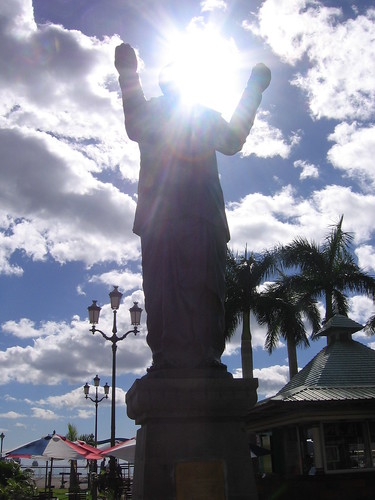The road to Xintiandi
This is the first chance I've had to gather my thoughts since getting back from Shanghai. It's a fantastic city - so dynamic. A taxi ride from Pudong airport to Xintiandi downtown is like no other journey in the world. (Assuming you make it: Shanghainese drivers love to change lanes for no apparent reason and with scant regard for other road users). Leaving the hypermodern airport and driving alongside the Maglev track (at 430 kmh, the world's fastest train), the manicured roadsides, high-tech business parks, shopping malls and private housing estates (some of which look like Barratt Homes with Chinese eaves) are redolent of US edge cities such as Plano, Texas.
Closer to the river, the buildings become taller, a thicket of office blocks and new appartments, many still under construction. In this part of Pudong, where the taxi drivers frequently get lost, it is normal to pass a building one day and see a whole new section added to it the next. The pace of change is incredible - it feels like being in Manhattan as it is being built. Crossing the Huangpo and leaving the special economic zone (a swamp 15 years ago) for Puxi, the traditional heart of Shanghai brings a rush of a different kind. Now you real feel like you are in one of the world's most populous cities. Buildings crowd in on the highway from all sides; a profusion of signs, sounds and smells. Old men with half a shop of the back of their bicycles; twentysomethings in an SUV wearing Ralph Lauren: Jon Hassell's 'Fourth World' concept brought to glorious life.
And then the driver pulls over, you are paying him (no tip, don't forget your receipt). And you are walking into a gentrified version of 1920s Shanghai: Xintiandi.
Saved from the bulldozers by a perceptive property developer in 1997 and now the favourite haunt of Shanghai's beautiful people, expats and Western tourists, Xintiandi houses hip clubs, arts and crafts stores, a Starbucks and the fantastic restaurant/gallery TMSK (pot roast with oyster sauce, mmm) among other toney things. It was also the site of the first meeting of the Chinese Communist Party back in 1921. The building in question is now a museum. I spent a diverting half hour there, virtually alone. A sign of how much China has changed in the 28 years since Mao's death.
Closer to the river, the buildings become taller, a thicket of office blocks and new appartments, many still under construction. In this part of Pudong, where the taxi drivers frequently get lost, it is normal to pass a building one day and see a whole new section added to it the next. The pace of change is incredible - it feels like being in Manhattan as it is being built. Crossing the Huangpo and leaving the special economic zone (a swamp 15 years ago) for Puxi, the traditional heart of Shanghai brings a rush of a different kind. Now you real feel like you are in one of the world's most populous cities. Buildings crowd in on the highway from all sides; a profusion of signs, sounds and smells. Old men with half a shop of the back of their bicycles; twentysomethings in an SUV wearing Ralph Lauren: Jon Hassell's 'Fourth World' concept brought to glorious life.
And then the driver pulls over, you are paying him (no tip, don't forget your receipt). And you are walking into a gentrified version of 1920s Shanghai: Xintiandi.
Saved from the bulldozers by a perceptive property developer in 1997 and now the favourite haunt of Shanghai's beautiful people, expats and Western tourists, Xintiandi houses hip clubs, arts and crafts stores, a Starbucks and the fantastic restaurant/gallery TMSK (pot roast with oyster sauce, mmm) among other toney things. It was also the site of the first meeting of the Chinese Communist Party back in 1921. The building in question is now a museum. I spent a diverting half hour there, virtually alone. A sign of how much China has changed in the 28 years since Mao's death.
Labels: On the road

0 Comments:
Post a Comment
<< Home